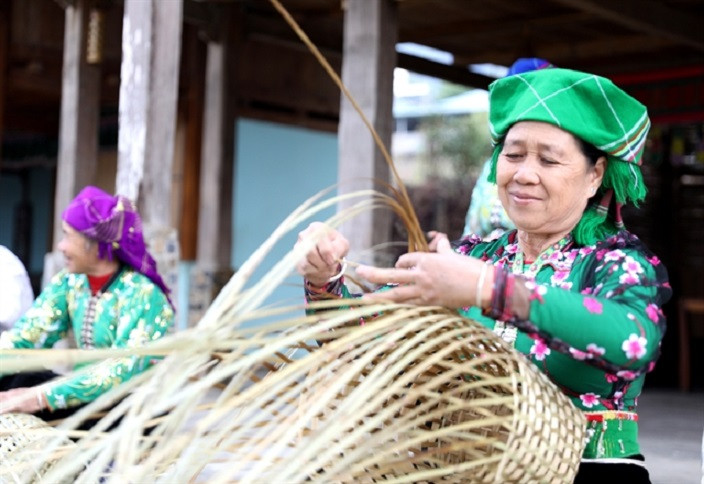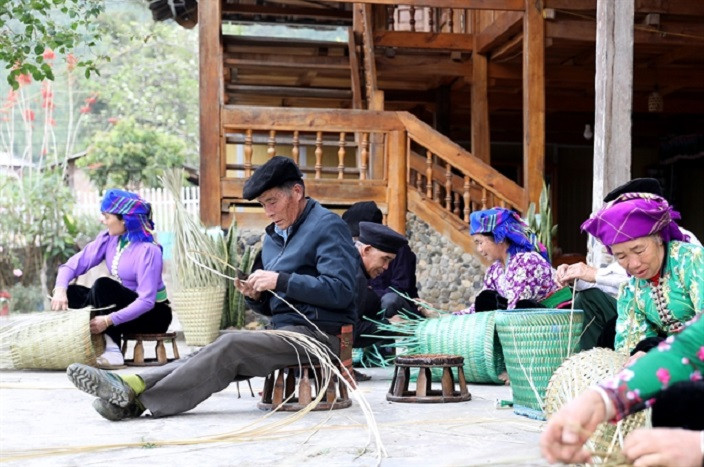
To preserve traditional bamboo and rattan weaving craft, Thái ethnic people in Ngọc Chiến Commune, Mường La District, of the northwestern province of Sơn La have established the Bamboo and Rattan Wickerwork Preservation Club.
The bamboo and rattan wickerwork is not only exquisite, durable, and eco-friendly, but they also represent the cultural essence of the Thái people here and offer tourism potential.
“Nobody knows the exact beginnings of rattan and bamboo weaving craft; all that is known is that traditional weaving practices have been preserved and passed down through the generations of Thái people in Ngọc Chiến,” Tòng Thị Lẹn, a member of the club, said.
Every day, Lẹn weaves bamboo and rattan backpacks for working in the forest, most of which are often sold to Mông ethnic people in the commune. She can weave a backpack a day and sell it for VNĐ150,000 (US$6).
“As a 65-year-old woman, I am not strong enough to do farming. Bamboo weaving has allowed me to increase my income, bringing in between VNĐ3-4 million a month, without having to depend on my children and grandchildren,” Lẹn said.
The income from the weaving craft also improves the livelihoods of 64 member households of the club.
The bamboo and rattan wicker items with different designs and shapes range from household items, including rattan trays and storage baskets, to furniture such as sofas, shelves, tables, chairs and stools.
Customers from both inside and outside the province order the durable and diversified designed products.
“The annual income of all member households combined is from VNĐ1.8 to 2 billion,” Lò Văn Khoan, 64, the president of the club, said.
Preservation challenge

However, young people in Ngọc Chiến Commune today have gradually lost interest in wickerwork, and are reluctant to take up the ancient craft – they see it as something from which they are unable to make ends meet, and the preserve of the elderly only.
“All the members in the club are elders from the village, older than 50. Practising and preserving bamboo and rattan craft is not something that the younger generation engages in,” Khoan said.
The younger Thái natives of the commune frequently opt to work in industrial parks in provinces or pursue higher education with the promise of a brighter future and higher income. They, however, take part in the commune's tourism-related activities.
As Ngọc Chiến becomes an attractive destination, the local authorities have worked out a plan to make the rattan and bamboo weaving craft of the Thái a unique tourism product.
“Ngọc Chiến Commune is focusing on building tourism on its distinctive cultural values to enhance tourism-dependent communities' livelihood sustainably and drive economic growth,” said Bùi Tiến Sỹ, the Secretary of the Communist Party Committee of Ngọc Chiến Commune.
“The commune aims to establish a bamboo and rattan wickerwork cooperative with 200 to 300 households participating. We plan to invest in technology and machinery to improve the quality, design, and competitiveness of Ngọc Chiến wickerwork. The commune also aims to build up a community cultural house in Lưới Village so that tourists can try their hand at making bamboo and rattan products. At the same time, the locals can sell their wares to tourists, bringing in extra income for them."
Sỹ said he hopes the more income the locals receive from handicrafts, the more young Thái will participate in preserving and promoting this ancient craft. VNS